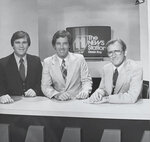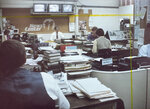

“When I took over as manager of WLUK in 1967, its news ratings amounted to a measly 6% of the market. Competitors at WFRV had 26% of the audience and WBAY held a whopping 68%,” former general manager Tom Hutchison recalled.
“WLUK’s news department [had] just seven staffers trying to compete against stations that had more than 20 each. Channel 11 was able to put on its half-hour news shows at 6 p.m. and 10 p.m., but the other stations had additional news at noon and in the early morning.”
To get the company to invest more in the news department, the staff needed to work to get their ratings up.
“We struggled for a few months until I finally met with Dave Nelson and Vic Minahan at the Minahan family cottage in Door County and suggested we take a giant gamble. Let’s shut down the news department completely and not start again until we have the budget to be competitive, I told them. We were simply wasting money and effort,” Hutchison explained.
“To meet our commitment to the FCC to air news, public affairs and other local programming, we’d expand our remote telecasts to include everything the FCC required to keep our license.”
On Oct. 16, 1967, WLUK took the news off the air, and it stayed off until they were financially sound — for three years.
“At our budget meeting in the fall of 1970, WLUK received a commitment from Post Corporation to re-enter the news business,” Hutchison said.
Earlier that year, WLUK brought a new show to the Green Bay area that was produced by the Children’s Television Workshop in New York with $8 million in funding from the Ford and Carnegie Foundations and the U.S. Office of Education.
While WLUK went head-to-head with WBAY to gain the rights to air, WLUK came out on top and worked around the time slot in which WBAY was airing its “Captain Kangaroo” show for children.
Sesame Street became an instant hit at the station and in Green Bay homes — an advertisers’ dream.
In December of 1970, Tom Torinus was brought on as a news director with plans to have a news team in place by the following summer.
On July 5, 1971, WLUK quietly reentered local news broadcasting.
By the first year, the station’s ratings rose to 13%.
The following year, it went up to a 20% share in the market.
By the third year, the news audience had reached 23%.
To be continued